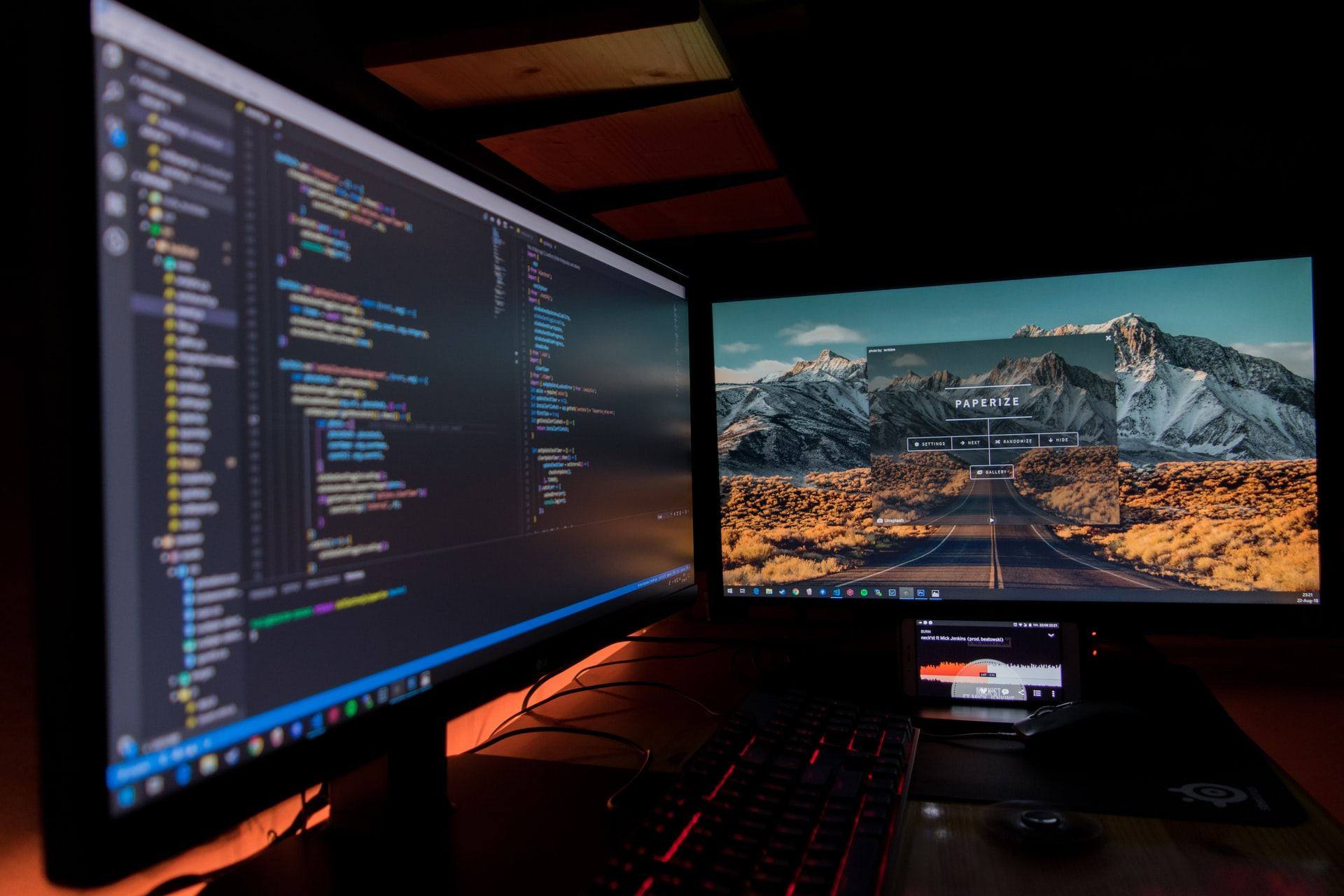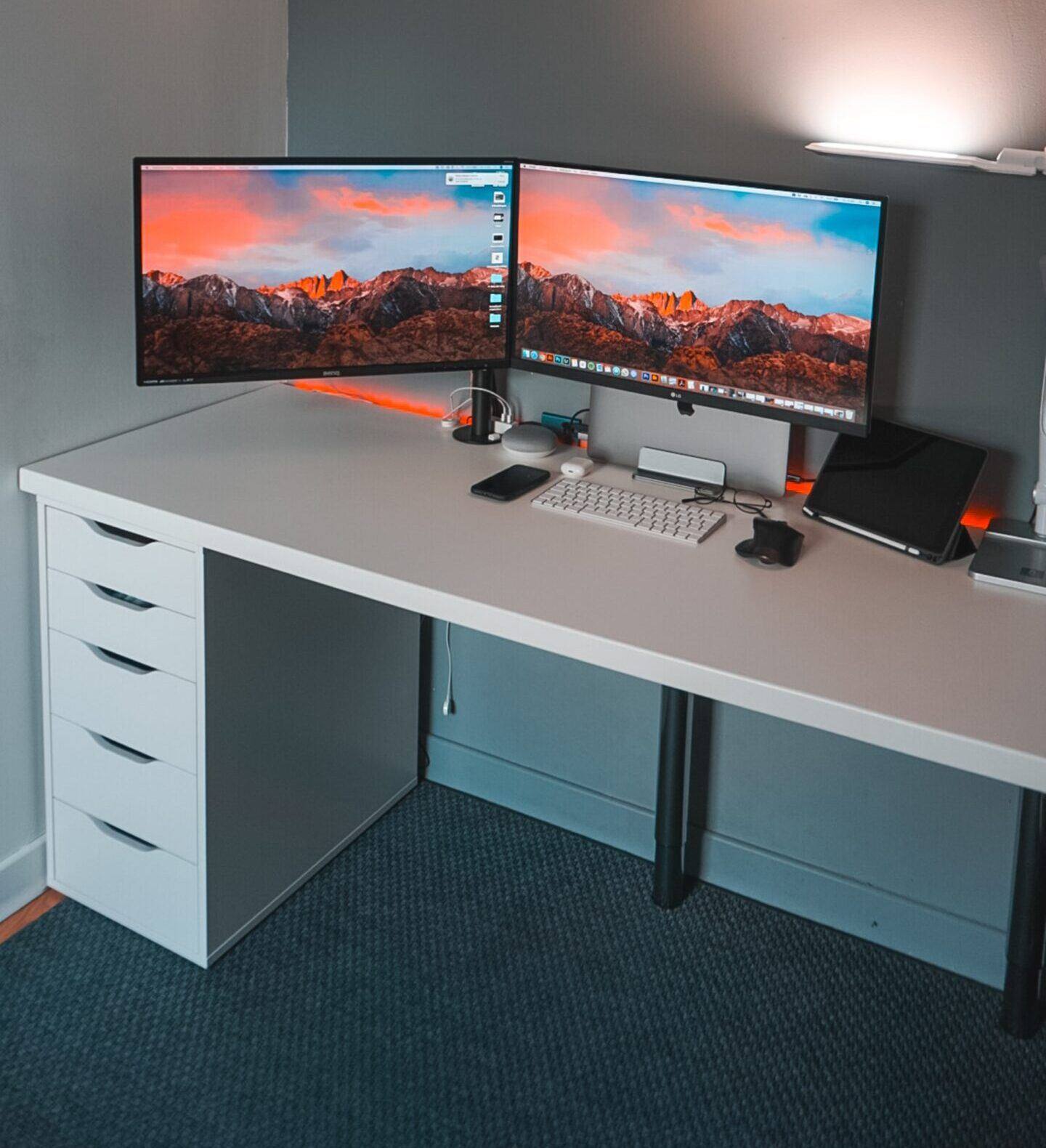The Benefits of Dual Screen Monitors

When one screen is not enough, dual monitors provide an effective solution. You may not be able to get your head around working with two screens vs one at first, but there’s actually a number of significant benefits to this madness.
Dual screen monitors – also known as an extended desktop – is actually not such a new concept. It didn’t become an overnight sensation, of course, but it is growing in popularity among a high number of computer users that toggle between screens and multitask.
The key benefit is obvious. Two screens effectively extend your visual real estate and help to make workflow smoother. Dual monitors enhance productivity, efficiency and user satisfaction. Dual screens actually offer more than you might imagine.
Who Are Dual Monitors For?
Working with two screens is slowly becoming more widespread. A growing number of workers are finding dual-monitor workstations enable them to perform their job easier.
With the growth of distributed workforces over the last year, dual monitors are even moving into Work-from-Home environments. The kids love them because they can watch films on cinema-sized screens and enhance their gaming experience.
The list below is not exhaustible:
- Engineers
- Paralegals and solicitors
- Accountants
- Computer programmers
- Web designers
- Graphic designers
- Architects
- Account Managers
- Office Administrators
- Writers and researchers
- IT Consultants and IT Support Teams
- Social media consultants
- Data analysts
- Financial analysts
- Interior designers
- Fashion designers
- Customer support teams
- Virtual meetings
- Content creators
- PowerPoint Users
- Image and video editors
How Do Dual Screen Monitors Work?
Dual monitors give you more visibility and eliminate the need to open multiple windows. Essentially, you eliminate having to toggle between one website and the next or from a research paper to a Word doc etc.
For example, a researcher or analyst preparing a report can bring up a series of complex charts on the second screen and type the relevant information in the document you are creating on the other screen. There’s no need to remember facts and figures when you are staring straight at them.
Video and photo editors avoid stacking up multiple editing tools on top of videos or images. It’s far easier to leave your jigsaw piece on one screen and drag them over to the piece you’re working on when you need them.
You get the idea. Let’s take a closer look at the benefits dual screen monitors offer.
Two Monitors Increase Productivity
If your job involves flicking between tabs or programs on a regular basis, dual screens can speed up the process. Although the time saved for every single tab switch is fractional, when you account for the number of times you perform a toggle, it all adds up.
When you factor in the time you lose from errors and loss of concentration having jumped from one window to another, the amount of lost productivity stacks up pretty quickly. As a matter of fact, several studies conclude that working with dual monitors can ramp up your overall productivity by up to 42%.
The minute detail in some jobs makes information difficult to remember when you’re toggling between screens.
Computer programmers, for example, can use one screen for source coding and the other for programming. Account managers making ROI decisions can assess multiple spreadsheets to weigh up capital versus productivity.
Eliminating your daily screen juggling results in fewer interruptions in which time you lose your trail of thought. Researchers estimate it can take around 23-minutes to refocus after losing your thread.
Dual Screens Help You Organise Windows
The number of video conferences taking place among team members and professional-client consultations has multiplied dramatically in the last year. With Work-From-Home policies (WFH) set two continue, dual monitors can make your meetings run more smoothly.

Co-workers that are collaborating often have to switch between documents, files, apps, webpages, dashboards etc. You name it, you have to toggle to it. This can be distracting and frustrating for some people. It also slows progress.
Two screens mean you can have a face-to-face, albeit virtual, meeting with a colleague in Microsoft 365’s Teams, whilst maintaining the visibility of the documents you are referring to on the other screen.
This makes your desktop less cluttered, more organised and easier to work with. You probably already know this from experience. How many times have you needed to refer to information on another screen and used the words: “Oh, where is it? Hang on a sec, it’s here somewhere.”
Sound familiar?
The same rules apply when you are speaking with clients. It feels much more professional when you effortlessly locate a file on the grounds that you know where it is located without having to flick through a bunch of open windows when you toggle out of the video screen.
When you’re on a video call, two screens even make simple tasks easier. For example, keeping your email or calendar visible so you can check dates at a glance or take notes during a brief or meeting.
What you ultimately find in these types of situations is that you are able to stay focused and better connected with the people you are having a video conference with.
Two Monitors Improve Efficiency
Efficiency and convenience make your work life – and your brain – run smoothly. The multitaskers among you are all too aware of the problems you encounter on a daily basis when you have multiple tabs open. Dual monitors make working with multiple documents far easier.
Copy-pasting into a lengthy document with numerous sections is a prime example. Whilst you are researching you will naturally come across information from a study that is relevant to more than one section.
When you flick between screens, it’s more difficult to remember which piece of information goes in which section without revisiting your thought process. That’s because your attention has been distracted by the switch and then scrolling up and down in the document you are working in to find the right space.
Researchers have discovered that having too many tabs open is not productive at all. You may think that “tab switching” can make you more efficient but in actual fact, it’s scattering your brain.
When you flick between tabs and windows etc, your brain has to switch tasks. Each time you switch your attention to a new screen, you momentarily lose concentration. Toggling is not only an inefficient way to work, it also has a negative effect on your mental wellbeing.
Two Monitors vs One Screen
For businesses and freelancers, an increase in productivity and efficiency directly correlates to an increase in profit. However, it’s also worth bearing in mind that having too much screen real estate can also make you less efficient and productive.
When considering whether two monitors are better than one screen there are several benefits and disadvantages to consider. There are also two ways to address the dual monitors versus single screen debate.
- Are you moving from one small screen with a standard aspect ratio of 16:9 to dual monitors or
- Are you contemplating investing in an ultra-wide monitor with an aspect ratio of 21:9 which you can split into two screens?
The Benefits of Ultra Wide Monitors
Traditionally, an extended desktop consists of dual monitors with a standard 16:9 aspect ratio. This is an ideal set up to take advantage of the benefits of dual screen monitors.
In recent years, ultra-wide monitors have crept into the marketplace. Boasting a 21:9 aspect ratio and split-screen, ultra-wide monitors may prove to be a better solution than dual screen monitors.
The option you choose will ultimately depend on how much screen space you need to lay out everything you need to work with. For most people, the 21:9 aspect ratio of ultra-wide screens will suffice. And they are even easier to work with than dual monitors.
The “bezel gap” between the monitors is completely eliminated whereby your eyes shift seamlessly from your source document to your work document – or whatever task you are performing.
In an ideal world, your dual monitor setup will have the same size screen, resolution and colour. Unless you purchase matching monitors this may not be the case.
For some jobs, such as designers, video editors and photographers, this mismatch could be problematic. Ultra-wide screens do not have colour fluctuations and can improve the quality of your work by removing potential inconsistencies.
Setting Up Dual Screen Monitors
Designing and installing an extended desktop is straightforward and relatively inexpensive. However, problems can arise. For example, if you are using a dual monitor setup with a laptop, your portable device ideally needs an internal graphics card that can support your dual monitors.
Syncing the two monitors is also simple if you know your way around computer settings. The setup process will depend on the operating system you’re using.
For example, Windows computers enable you to set up dual monitors on Windows 10 by following the instructions provided by Microsoft. Setting up dual screen monitors from an Apple Mac is slightly different.
Working with an outsourced IT support team will also resolve any problems you may encounter. Our experts will help you troubleshoot any issues and can demonstrate how to make the best use of this setup. If your business premises are based in London or the surrounding areas, our IT support team could not only help choose and procure the best monitors for your needs but can attend your place of work and implement the dual-screen setup for you.
Our dedicated team of IT experts are dedicated to improving productivity in your Business, ensuring your staff are able to work efficiently and with minimal disruption. Call us anytime you need advice and assistance.
